(Carakan) 
The earliest known writing in Javanese dates from the 4th Century
AD, at which time Javanese was written with the Pallava alphabet.
By the 10th Century the Kawi alphabet, which developed from Pallava,
had a distinct Javanese form.
For a period from the 15th century onwards, Javanese was also written with a version of the Arabic alphabet, called pegon.
By the 17th Century, the Javanese alphabet had developed into its current form. During the Japanese occupation of Indonesia between 1942 and 1945, the alphabet was prohibited.
Since the Dutch introduced the Latin alphabet to Indonesia in the 19th Century, the Javanese alphabet has gradually been supplanted. Today it is used almost exclusively by scholars and for decoration. Those who can read and write it are held in high esteem.
Notable features
- Type of writing system: syllabic alphabet - each letter has an inherent vowel /a/. Other vowels can be indicated using a variety of diacritics which appear above, below, in front of or after the main letter.
- Direction of writing: left to right in horizontal lines
- The Javanese alphabet consists of akṣara (letters), saṇḍangan (diacritics), wilangan (numerals), and pada (punctuation).
- The akṣara (letters) consist of akṣara wyanyjana (consonants) and akṣara swara (vowels); the saṇḍangan (diacritics) consist of saṇḍangan swara (vowel diacritics), saṇḍangan panyigeging wanda (sound killers), and saṇḍangan wyanyjana (semivowel diacritics).
- Each consonants has two forms: the akṣara form is used at the beginning of a syllable, while the pasangan form is used for the second consonant of a consonant cluster and mutes the vowel of the akṣara.
- There are a number of consonants letters called akṣara murda or akṣara gêḍe (great or important letters) which are used for honorific purposes, such as to write the names of respected people. There are also a number of additional consonant letters to represent foreign sounds called akṣara rekan.
- The order of the carakan consonants makes the following saying, "Hana caraka, data sawala, paḍa jayanya, maga baṭanga," which means, "There were (two) emissaries, they began to fight, their valor was equal, they both fell dead."
Used to write:
Javanese (baṣa Jawa), an Austronesian language spoken by about 80 million people in Indonesia and Suriname. In Indonesia Javanese is spoken in Java, particularly in central and east Java, and on the north coast of West Java, and in Madura, Bali, Lombok, and in the Sunda region of West Java. Javanese alphabet also can be used to write old Javanese.Javanese was used as the court language in Palembang, South Sumatra until the late 18th century and has been used as a literary language for over a millenium. It currently has no official status though is recognised as a regional language in Central Java, Yogyakarta, and East Java. It is taught in some schools, and there are some radio and TV programmes in Javanese, as well as a number of magazines. The Javanese alphabet was also used to write Balinese and Sundanese, but has been replaced by the Latin alphabet.
The Javanese alphabet
Akṣara Wyanyjana (Consonants)
Akṣara Carakan and Pasangan
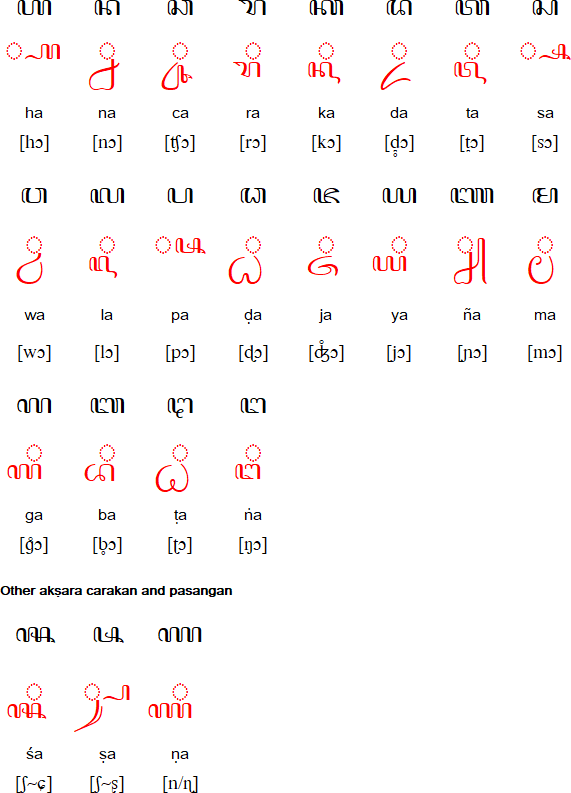
Notes
- The pasangan (final consonants) are shown in red and are used at the ends of syllables.
- ḍa (ɖa) and ṭa (ʈa) are usually written dha and tha. ḍa and ṭa are used here to differentiate dha (ɖa) and tha (ʈa) in modern Javanese and dha (d̪ha) and tha (t̪ha) in old Javanese.
Akṣara murda consonants
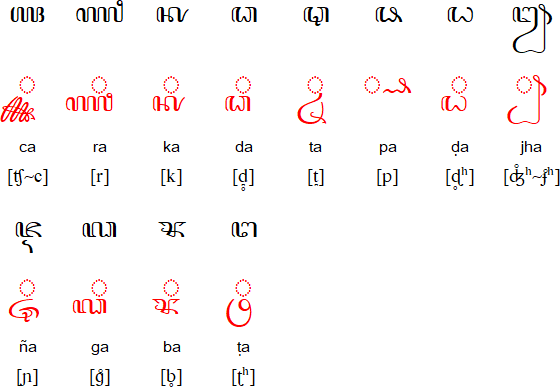
The pasangan (final consonants) are shown in red. ka, ta, pa, ga and ba are most commonly used. The others are rarely used.
Akṣara for writing Old Javanese
To write old Javanese some of the letters are aspirated. The arrangement of consonants is based on standard Sanskrit.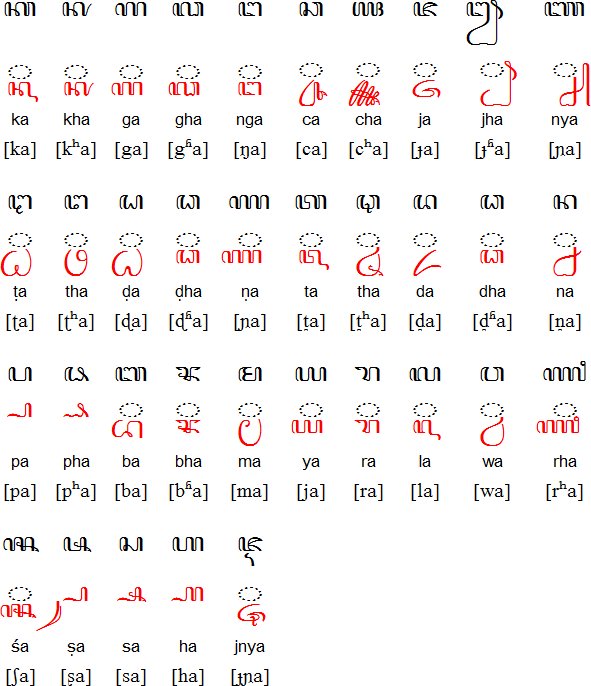
Akṣara Rekan (additional consonants)
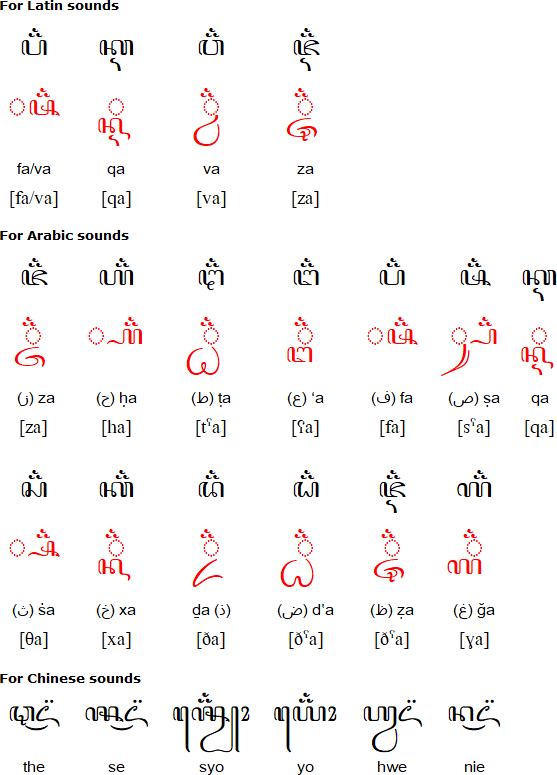
Vowels and vowel diacritics (Akṣara Swara & Saṇḍangan Swara)
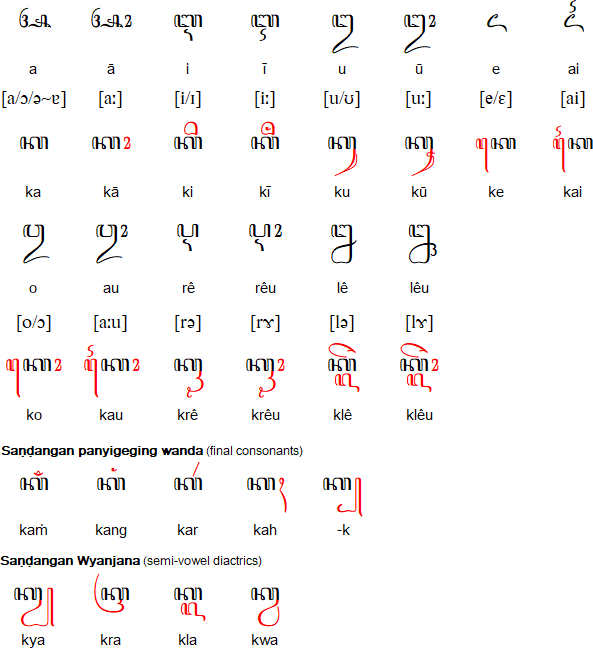
Note: rê, rêu, lê, and lêu are also treated as consonants. So they have pasangan:

The long vowels (ā, êu, ī, ai, rêu, lêu, ū, and au) are no longer used in modern Javanese, but just for special purposes like writing old Javanese and transliterating foreign sounds.

Numerals (Wilangan)

The first line of numbers are native Javanese ones; the second line of number are adapted from Sanskrit.
Punctuation (Pada)
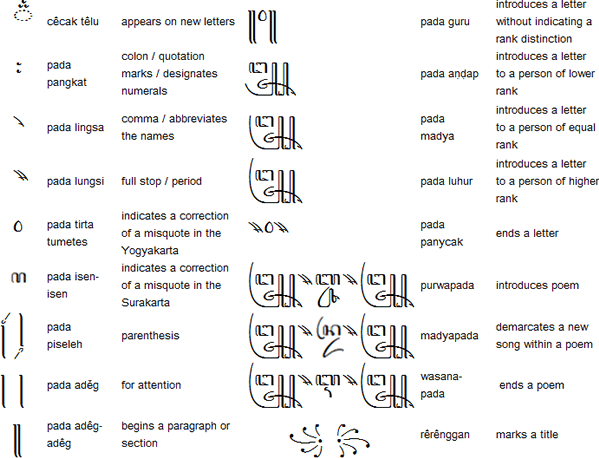
Sample text in the Javanese alphabet
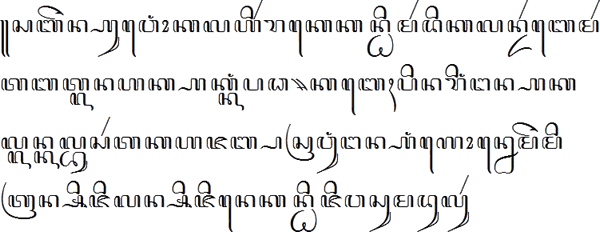
Text provided by Aditya Bayu, with corrections by Hafidh Ihromi
Transliteration
Sabên wong kalairake kaṇṭi mardika lan darbe martabat lan hak-hak kang paḍa. Kabeh pinaringan akal lan kalbu sarta kaajab pasrawungan anggone mêmitran siji lan sijine kaṇṭi jiwa sumadulur.Translation
All human beings are born free and equal in dignity and rights. They are endowed with reason and conscience and should act towards one another in a spirit of brotherhood.(Article 1 of the Universal Declaration of Human Rights)
Another sample text in the Javanese alphabet (Lord's prayer)
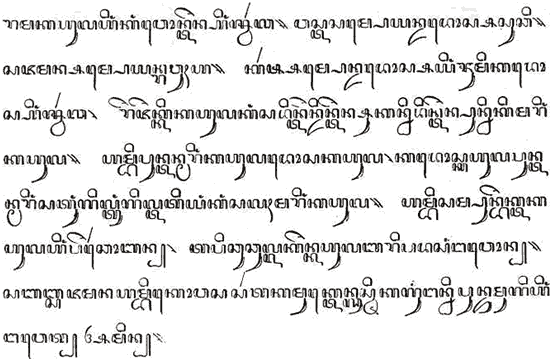
Transliteration
Rama kahula hīkā wonten 'ī swarga. wasta sampeyan dadossa subši. sadžaman sampeyan rawuḥha. kars sampeyan dadossa 'ī bumi kados 'ī swarga. redžekki kahula kā saintendinten sukanni dinten puniki marī kahula. hambi puntan marī kahula dosa kahula, kados kahula puntan marī satungiltūgil titiyū kā salaḥ marī kahula. hambi sampun bekta kahula 'ī pertšoban. tapi tšutšullken kahula bari pada sā ṅawon, sabab sadžaman hambi kawasa sarta kamukten gusti kagū ṅannipun dumugi 'ī ṅawet. AminLatin alphabet for Javanese
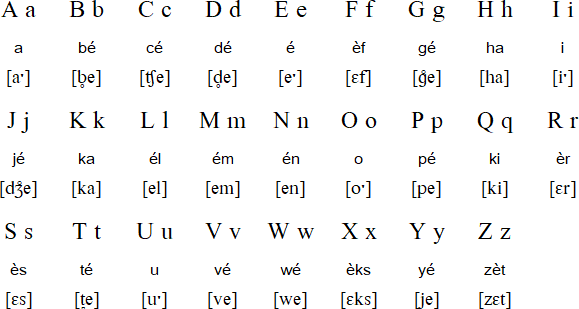
Javanese pronunciation
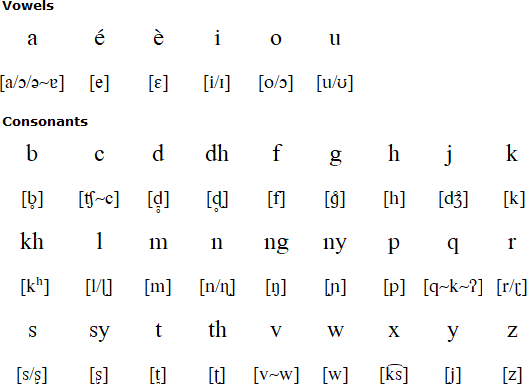
Note: n and ṇ are usually written n; ś and ṣ are usually written s; and ḍ and ṭ are usually written dh and th.
Information about the Javanese Latin alphabet and pronunciation compiled by Wolfram Siegel, with corrections and additions by Nurrahim Dwi Saputra
Sample text in Javanese
Sabên wong kalairake kaṇṭi mardika lan darbe martabat lan hak-hak kang paḍa. Kabeh pinaringan akal lan kalbu sarta kaajab pasrawungan anggone mêmitran siji lan sijine kaṇṭi jiwa sumadulur.A recording of this text
Translation
All human beings are born free and equal in dignity and rights. They are endowed with reason and conscience and should act towards one another in a spirit of brotherhood.(Article 1 of the Universal Declaration of Human Rights)
Information about Javanese
Useful phrases in Javanese |
Numbers in Javanese
Tower of Babel in Javanese |
Javanese learning materials
Links
Information about the Javanese alphabethttp://www.joglosemar.co.id/hanacaraka/hanacaraka.html
http://www.christusrex.org/www1/pater/JPN-javanese-huruf.html
Online Javanese lessons
http://www.seasite.niu.edu/Indonesian/jawa/jawa.htm
Hear the sounds of the Javanese alphabet
http://hanacaraka.fateback.com/aksjwi.htm
The Official Site of Akṣara Jawa - free fonts and a tutorial on how to write with the Javanese alphabet (in Javanese and Indonesian)
http://hanacaraka.fateback.com
Javanese fonts
http://www.adjisaka.com
https://sites.google.com/site/jawaunicode/main-page
http://www.reocities.com/jglavy/asian.html









.jpg)
.jpg)

.jpg)





0 comments:
Post a Comment
Note: Only a member of this blog may post a comment.